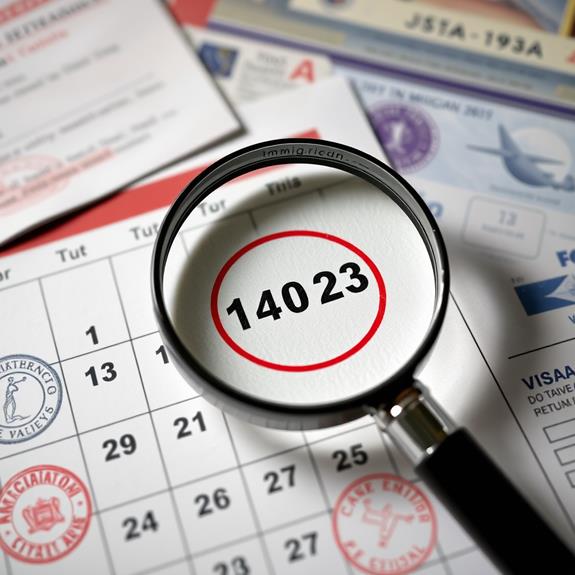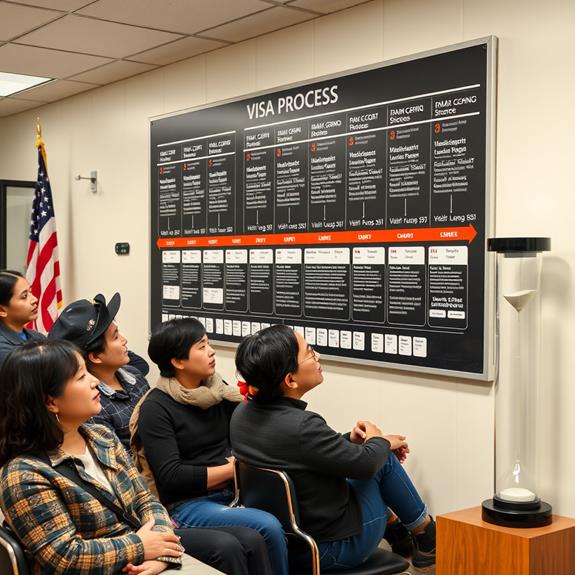The family-based green card processing timeline varies widely based on your specific category and circumstances. For immediate relatives of U.S. citizens, the process typically takes 8 to 14 months. Family preference categories often face longer waits due to annual visa caps. The timeline includes filing Form I-130, waiting for priority dates to become current, and completing either consular processing or adjustment of status. Factors like USCIS workload, case complexity, and your location can affect processing times. You'll need to prepare documents, undergo a medical exam, and possibly attend an interview. Understanding each step and staying informed about visa bulletins can help you navigate the process more effectively.
Understanding Family-Based Green Card Categories

When it comes to family-based green cards, understanding the different categories is vital. The U.S. immigration system classifies family relationships into specific groups, each with its own set of rules and processing times. These categories determine your immigration eligibility and affect how long you'll wait for your green card. Expert guidance can help simplify the complexities of the family immigration process and initiate the green card process for eligible family members.
There are two main types of family-based green cards: immediate relative and family preference. Immediate relatives include spouses, unmarried children under 21, and parents of U.S. citizens. These applicants typically have shorter wait times. Family preference categories cover other relatives, such as adult children, siblings, and spouses of permanent residents.
Your specific category depends on your relationship to the U.S. citizen or permanent resident sponsoring you. For example, if you're the spouse of a U.S. citizen, you fall under the immediate relative category. However, if you're the married adult child of a U.S. citizen, you'd be in a family preference category.
Understanding these distinctions is significant because they impact processing times and visa availability. Immediate relatives don't face annual visa limits, while family preference categories have caps, leading to longer wait times.
Initial Petition Filing Process
In light of your eligibility for a family-based green card, the initial petition filing process marks the first vital step towards obtaining permanent residency. You'll need to submit the appropriate petition form based on your relationship to the U.S. citizen or permanent resident sponsor. The most common initial petition types include Form I-130 for immediate relatives and family preference categories. Expert guidance can be invaluable during this stage, ensuring you navigate the complex regulations effectively and minimize potential errors or delays.
When completing your petition, pay close attention to detail to avoid common mistakes that could delay your application. These errors often include incomplete forms, missing signatures, or insufficient supporting documentation. Be sure to gather all required documents, such as birth certificates, marriage certificates, and proof of your sponsor's U.S. citizenship or permanent residency.
After assembling your petition package, double-check everything before submitting it to U.S. Citizenship and Immigration Services (USCIS). Include the correct filing fee and follow the specific mailing instructions provided by USCIS. Once your petition is received, USCIS will send you a receipt notice confirming they've started processing your case. This notice is vital for tracking your application's progress throughout the green card process.
Priority Dates and Visa Bulletins

Understanding priority dates and visa bulletins is essential for family-based green card applicants. Your priority date is the day USCIS receives your petition. It's vital because it determines your place in line for a green card. The visa bulletin, published monthly by the State Department, shows which priority dates are current for each visa category. Consular processing plays a significant role in this process, especially for applicants outside the United States. Familiarizing yourself with the steps involved can help you better prepare for your journey.
Priority date impacts vary depending on your visa category and country of origin. Some categories, like immediate relatives of U.S. citizens, don't have to wait for a priority date to become current. Others may face long waits, especially if they're from countries with high immigration rates. You'll need to check the visa bulletin regularly to see if your priority date is current.
Visa bulletin updates can bring good or bad news. Sometimes, priority dates move forward quickly, shortening wait times. Other times, they may stall or even move backward, a process called retrogression. It's important to stay informed about these changes. When your priority date becomes current, you can move forward with your green card application. This step brings you closer to obtaining permanent residency in the United States.
Preparing for Consular Processing
As you prepare for consular processing, you'll need to gather several important documents. These typically include your passport, birth certificate, police records, and financial information. You should also start preparing for your medical examination, which is a required step in the green card process.
Gather Required Documents
Gathering the required documents is an essential step in preparing for consular processing. You'll need to follow a document checklist provided by the National Visa Center (NVC) to guarantee you meet all evidence requirements. This checklist typically includes items such as your passport, birth certificate, marriage certificate (if applicable), and police records. You'll also need to provide financial documents to prove you won't become a public charge in the U.S.
Make sure to collect original or certified copies of all required documents. If any documents aren't in English, you'll need to get them translated by a qualified translator. It's important to start gathering these documents early, as some may take time to obtain. Keep in mind that specific requirements can vary based on your individual circumstances and the country you're applying from.
As you collect your documents, organize them carefully and make copies for your records. Double-check that all information is accurate and up-to-date. If you're unsure about any requirements, don't hesitate to contact the NVC or consult with an immigration attorney for guidance.
Medical Examination Preparation
The medical examination is a key part of consular processing for your family-based green card. You'll need to schedule an appointment with an authorized physician to complete this essential step. During the exam, the doctor will assess your overall health and check for any conditions that might make you inadmissible to the United States.
Before your appointment, gather your medical history and vaccination records. You'll need to meet specific vaccination requirements, which vary based on your age and medical condition. The physician will review your immunization status and may administer any missing vaccines. Be prepared to fill out medical forms, including Form I-693, Report of Medical Examination and Vaccination Record.
The exam typically includes a physical check-up, chest X-ray, and blood tests for certain diseases. Your doctor will also evaluate your mental health and check for substance abuse issues. After completing the examination, the physician will seal your results in an envelope. Don't open this envelope; you'll need to submit it unopened with your green card application. Remember, medical exam results are valid for two years, so time this step carefully within your application process.
Adjustment of Status Requirements

Adjustment of Status requirements play an essential role in the family-based green card process. To apply, you must meet specific application eligibility criteria. First, you need to be physically present in the United States. You also must have entered the country legally, even if your current status has expired. Additionally, you should have an approved immigrant petition, typically filed by your U.S. citizen or permanent resident family member.
The eligibility criteria include being admissible to the U.S. and having a valid, unexpired passport. You'll need to prove you haven't violated certain immigration laws or committed specific crimes. Your relationship with the petitioning family member must be genuine and ongoing. You'll also need to show that you won't become a public charge, meaning you can support yourself financially.
To apply for Adjustment of Status, you'll file Form I-485 with USCIS. Along with this form, you must submit supporting documents like birth certificates, marriage certificates, and proof of your petitioner's status. You'll also need to provide evidence of your legal entry, such as copies of your visa and I-94 record.
Final Steps and Approval Timeline
After submitting your Adjustment of Status application, you'll enter into the final phase of the family-based green card process. This stage involves several key steps before you receive a final decision. First, you'll attend a biometrics appointment, where USCIS will collect your fingerprints and photo. Next, you may be scheduled for an interview with a USCIS officer. During this interview, they'll verify your information and assess your eligibility.
Following the interview, USCIS will review your case and make a decision. This process can take several months, and processing delays are common. Factors like your location, case complexity, and USCIS workload can affect the timeline. If USCIS needs more information, they'll send you a Request for Evidence, which can extend the process.
Once USCIS approves your application, they'll mail your green card to you. The entire process, from filing to approval, typically takes 8 to 14 months. However, some cases may be resolved faster, while others might take longer. It's important to stay patient and respond promptly to any USCIS requests to avoid further delays in your case.

